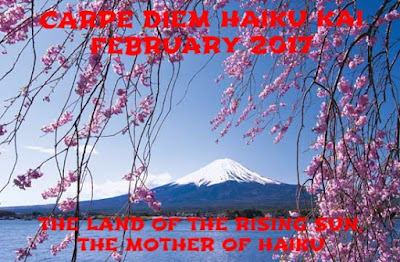Dear Haijin, visitors and travelers,
Welcome at a new episode of Carpe Diem Haiku Kai. This month we are travelling through Japan, the Motherland of Haiku. Yesterday we started with visiting the birthplace of Issa and today we are going to visit Matto, a village in Kaga Province, now Hakusan Ishikawa Prefecture, were another great haiku poet was born in 1703. Today we are visiting the birthplace of the most famous female haiku poet ever, Chiyo-Ni (1703-1775).
Chiyo-Ni is most known for her haiku about Morning Glory for example this one, her most famous haiku I think:
morning
glory!
the well bucket-entangled,
I ask for water
the well bucket-entangled,
I ask for water
(c) Chiyo-Ni
Let us take a look at Chiyo-Ni's place of birth. Matto unfortunately doesn't exist anymore because in 2005 it became part of the new town Hakusan. So to give you an idea of the region were Chiyo-Ni was born I have searched the Internet for a few images of Hakusan, Ishikawa Prefecture.
 |
| Hakusan, Ishikawa Prefecture's natural beauty (autumn) |
Look at all those beautiful colors in the mountains of Hakusan in Ishikawa Prefecture, the birth region of the most famous female haiku poet Chiyo-Ni. Must be awesome to live there and I think Chiyo-Ni found a lot of inspiration in her birth region.
A few of her haiku, which she wrote, maybe the mountains on the above image were her inspiration:
loneliness
lies within the listener -
a cuckoo’s call
lies within the listener -
a cuckoo’s call
on moor and
mountain
nothing stirs
this morn of snow
nothing stirs
this morn of snow
(c) Chiyo-Ni
In Hakusan, Ishikawa Prefecture, there is a shrine dedicated to Chiyo-Ni, she was buried in her birth place, which reflects what she once said:
[...] "Appreciate
each moment; that's all there really is. Be simple. Let my haiku teach you how.
Openness is all you need to understand my haiku. Just be open to each ringing
of the bell, each kiss, each pain, each word, each wind. Follow the fearless
path of white light, which covers everything, washes everything clean and white
and illuminated like clear water--drink the sweet water!" [...]
 |
| Shrine dedicated to Chiyo-Ni |
 |
| Shirayama Hime-Jinja Oku-miyaAdd caption |
Around Mount Hokusan Japan created a National Park. Mountains are the greatest things to see there. On the slopes of the mountains you can find the most beautiful flowers. The flora is a great source of inspiration and I think Chiyo-Ni was very inspired by the region of her birth.
 |
| flowers on the slopes of Mt. Hakusan |
Maybe that second image was one of her inspirations, because it's a kind of Morning Glory you see on that image. So I have another beauty by Chiyo-Ni for you:
morning
glories -
awakened
in the middle of a dream
awakened
in the middle of a dream
morning
glory -
the truth is
the flower hates people
the truth is
the flower hates people
(c) Chiyo-Ni
It was a pleasure to create this episode. I hope you did like it and of course I hope that it will inspire you to create haiku, tanka or other Japanese poetry forms.
This episode is NOW OPEN for your submissions and will remain open until February 25th at noon (CET). I will try to publish our new episode, about Buson's birth-place, later on. For now ... have fun!


Well...there were 3 stunning haiku by Chio -no you rrsea rched and uncovered for us there. I thought her cuckoo haiku the best I have ever read, then read the flower one and am not sure. I think those two are both the best haiku I have ever read. Her second haiku just after the cuckoo, her moor haiju reminds me of your style a lot.
ReplyDelete